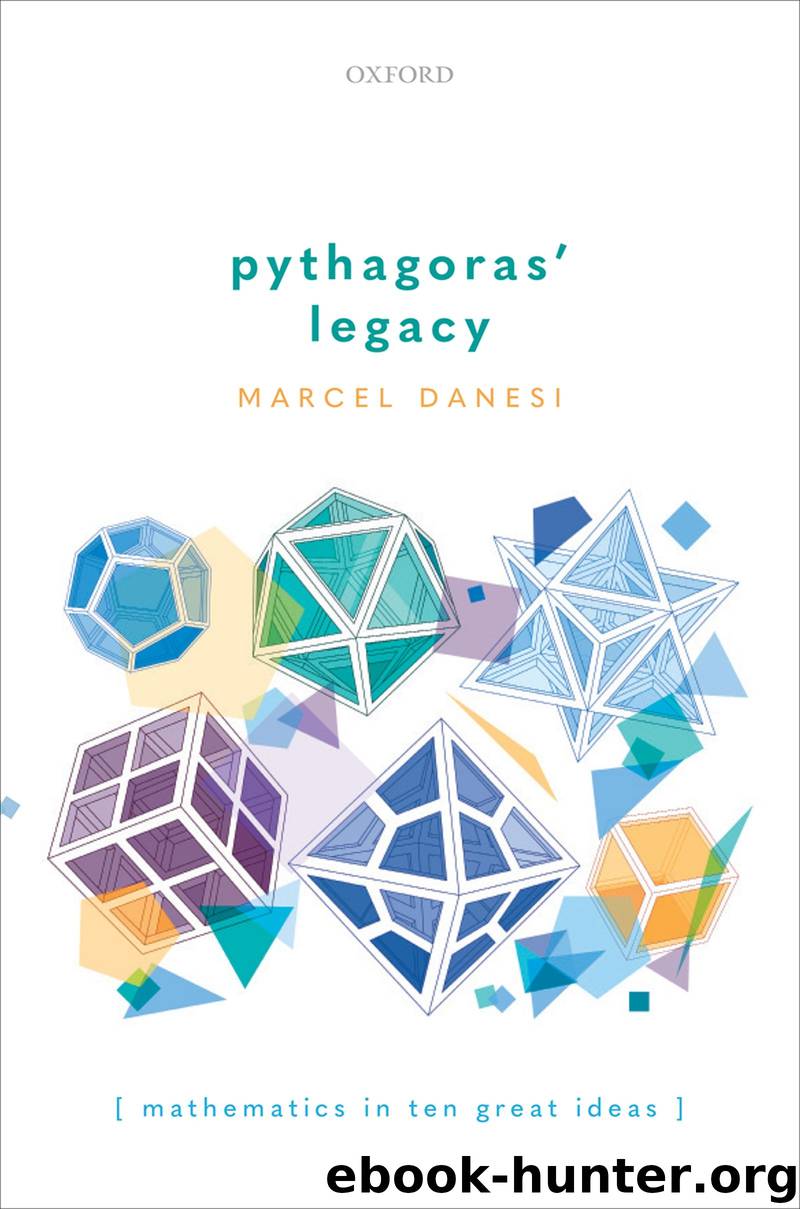Pythagoras' Legacy by Danesi Marcel;

Author:Danesi, Marcel; [Danesi, Marcel]
Language: eng
Format: epub
Publisher: Oxford University Press USA - OSO
Published: 2019-11-29T00:00:00+00:00
Epilogue
All of mathematics is encoded in symbolic notation. The Pythagorean equation c2 = a2 + b2, for example, is essentially a convenient notation of saying the same thing as the sentence “the square on the hypotenuse is equal to the sum of the squares on the other two sides.” In so doing, it takes the semantics in the linguistic sentence out, leaving only the structural (symbolic) outline of the information. It is this feature that makes it cognitively powerful, since we can now find many more meanings and applications for it, in addition to the original geometrical one. For example, one can now ask what integers fit the equation and, further, if there are other exponents for which the equation holds in general, cn = an + bn. From this deliberation on the notation itself, detached from its original geometrical meaning, has come much subsequent mathematical contemplation leading to such intriguing ideas as Fermat’s Last Theorem, as we saw. In other words, notation suggests meanings that could not otherwise be contemplated.
The ancients did not have exponential notation at their disposal, so they used other devices to accomplish many of the same things as the new notation allowed so efficiently. In his book, The Sand Reckoner, Archimedes discussed the notion of powers in a roundabout way. However, it did not allow him to develop such techniques as exponential laws and logarithms.
Einstein’s equation E = mc2 has imprinted in it a lot of information about physical reality that could not be expressed in any other way. It says, in a nutshell, that the speed of light is constant and thus that it constrains physical reality. What happens if there is a universe where this formula does not hold? It would be unimaginable, even though it is possible. Above all else, we would need a notation to devise formulas for such a universe. As the philosopher Ludwig Wittgenstein (1922) put it, “Whereof one cannot speak, thereof one must be silent.” As the language of Nature, mathematics breaks the silence periodically. E = mc2 speaks volumes, to belabor the point somewhat.
Download
This site does not store any files on its server. We only index and link to content provided by other sites. Please contact the content providers to delete copyright contents if any and email us, we'll remove relevant links or contents immediately.
| Applied | Geometry & Topology |
| History | Infinity |
| Mathematical Analysis | Matrices |
| Number Systems | Popular & Elementary |
| Pure Mathematics | Reference |
| Research | Study & Teaching |
| Transformations | Trigonometry |
Modelling of Convective Heat and Mass Transfer in Rotating Flows by Igor V. Shevchuk(6406)
Weapons of Math Destruction by Cathy O'Neil(6214)
Factfulness: Ten Reasons We're Wrong About the World – and Why Things Are Better Than You Think by Hans Rosling(4713)
A Mind For Numbers: How to Excel at Math and Science (Even If You Flunked Algebra) by Barbara Oakley(3256)
Descartes' Error by Antonio Damasio(3247)
Factfulness_Ten Reasons We're Wrong About the World_and Why Things Are Better Than You Think by Hans Rosling(3216)
TCP IP by Todd Lammle(3154)
Fooled by Randomness: The Hidden Role of Chance in Life and in the Markets by Nassim Nicholas Taleb(3080)
Applied Predictive Modeling by Max Kuhn & Kjell Johnson(3041)
The Tyranny of Metrics by Jerry Z. Muller(3028)
The Book of Numbers by Peter Bentley(2928)
The Great Unknown by Marcus du Sautoy(2661)
Once Upon an Algorithm by Martin Erwig(2621)
Easy Algebra Step-by-Step by Sandra Luna McCune(2603)
Lady Luck by Kristen Ashley(2553)
Police Exams Prep 2018-2019 by Kaplan Test Prep(2516)
Practical Guide To Principal Component Methods in R (Multivariate Analysis Book 2) by Alboukadel Kassambara(2512)
All Things Reconsidered by Bill Thompson III(2370)
Linear Time-Invariant Systems, Behaviors and Modules by Ulrich Oberst & Martin Scheicher & Ingrid Scheicher(2346)
